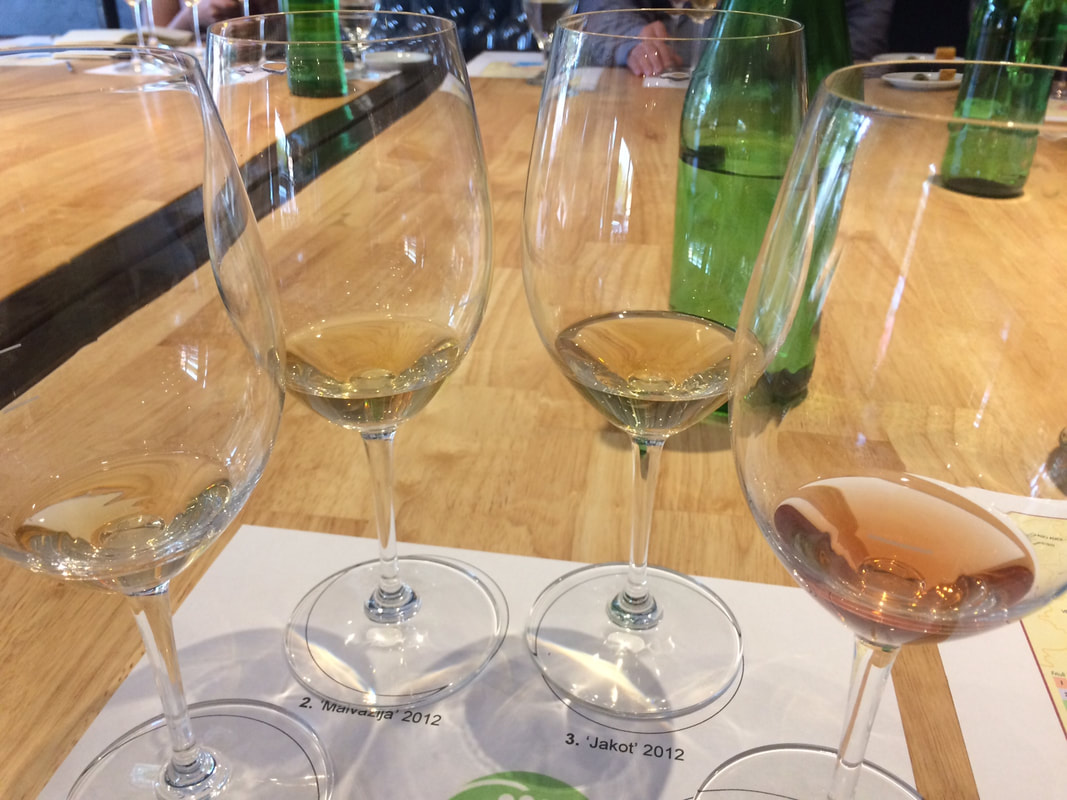Ribolla Gialla was responsible for the most intriguing stop on a busy wine tour of the Collio I was on a few years ago, a tasting with the newest generation of producers of the Associazione Produttori Ribolla di Oslavia, Primosic, Radikon, La Castellada, Dario Princic, Fiegl and Il Carpino at the Fiegl winery in Oslavia. Elsewhere in the Collio, the wines labeled Ribolla Gialla are light, usually meant for antipasti or as an aperitivo. For that duty several wineries create very enjoyable sparkling versions. In Oslavia, on the border with Slovenia, the wines of Ribolla Gialla are completely different.
Their signature wines made with the varietal are heavier, more complex, and just plain different. Oslavia is, after all, the spiritual home of orange wines and Ribolla Gialla is their vehicle. Orange wines are white wines made like red wines, with extended skin contact. The term orange refers to their hue. These wines can have a color that ranges from a deep yellow to amber to even orange. The prolonged contact with the skins results in tannins and additional body plus the darker color. This process provides a heft that otherwise could only come from a higher alcohol content or aging in newish wood. These wines also exhibit a greater complexity than most white wines and have the ability to age. Because of its thick skin, Ribolla Gialla is ideal for orange wines.
One of our hosts commented that “contact with skin can be the oldest or most traditional method” to make wine. It was used by the older generations simply to ensure that the wines would remain drinkable until the next vintage. With the diffusion of modern winemaking techniques this method eventually disappeared. It was revived by Josko Gravner in the 1990s, and it eventually caught on with some of his neighbors in the tiny hamlet of Oslavia and their brethren next door in Slovenia. Then winemakers elsewhere in Italy and in other countries picked up on it. Still fairly rare, these wines are a phenomenon on wine lists and in stores in just the past few years. Their uniqueness and relative scarcity have helped make them “the indie darling of the wine world” according to a Grub Street headline a few years ago, and an object of fascination for many sommeliers, especially those with a high hipster quotient, as Food & Wine noted.
During the Oslavia visit, we tasted Ribolla Giallas made with skin contact ranging from one week to three-and-a-half months. The ones we sampled at Feigl were not as atypical as the unusual winemaking process might suggest, and were notable for their dryness, balance, length of finish, and big mouth-feel.
The four orange wines from Klinec tasted at Vinology, featuring 100% each of Rebula (Ribolla Gialla), Malvasia Istriana, Friuliano, and Pinot Grigio, were broadly similar, but noticeably different in that these were not as big or bold as the wines I sampled at the winery in Oslavia. These were a lighter shade of orange, both in terms of hue and also taste. In contrast to the lengthy skin contact favored by the producers in Oslavia, Klinec allows skin contact for much less time, just between five and ten days for the wines at Vinology. I found these wines from Klinec still immensely flavorful, and these might be more approachable to the average wine drinker than the more typical of the orange wines from this part of the world. I really enjoyed all four, which drank well even without food, but with the substantial amount of acidity and minerality in each, these would make excellent partners for a wide variety of dishes, as Moësse pointed out. My favorite was the lightest, the Rebula, which I found to be the most vibrant and aromatic, and maybe refreshing soon after walking in from the 95-degree temperatures laden with humidity. The copper-hued Pinot Grigio, Gardelin on the label, was a close second, a little heavier, less perfumed, but with a fair amount of fruit and an incredible balance that was a feature of each of the four wines.
The wines are $41 at Vinology – for very well-made, expressive and interesting wines – and though drinking very well now, these should be even better in a few years and can likely easily last for another decade or longer.
Vinology
2314 Bissonnet (essentially at Greenbriar), 77005, (832) 849-1687
vinologyhouston.com
From left to right: Rebula, Malvasia Istriana, Fruilano, and Pinot Grigio

 RSS Feed
RSS Feed

